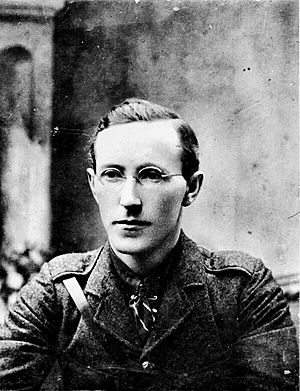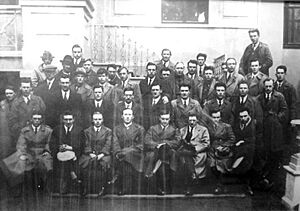Liam Lynch (Irish republican) facts for kids
Quick facts for kids
Liam Lynch
|
|
|---|---|
 |
|
| Chief of Staff of the Irish Republican Army | |
| In office 26 March 1922 – 10 April 1923 |
|
| Succeeded by | Frank Aiken |
| Personal details | |
| Born | 20 November 1892 Baurnagurrahy, Anglesboro, County Limerick, Ireland |
| Died | 10 April 1923 (aged 30) Clonmel, County Tipperary, Ireland |
| Military service | |
| Allegiance | |
| Branch/service | Irish Republican Army |
| Years of service | 1917–1923 |
| Rank | General |
| Commands | Officer Commanding, 2nd Cork Brigade, Irish Republican Army, 1919 – April 1921 Commander, First Southern Division, Irish Republican Army, April 1921 – March 1922 Chief of Staff, Irish Republican Army, March 1922 – April 1923 |
| Battles/wars | Irish War of Independence Irish Civil War † |
Liam Lynch (born William Fanaghan Lynch; 20 November 1892 – 10 April 1923) was an important leader in the Irish Republican Army (IRA). He fought during the Irish War of Independence (1919-1921). Later, he became the chief of staff of the IRA during much of the Irish Civil War. Liam Lynch died on 10 April 1923, while trying to escape from Free State soldiers in County Tipperary.
Contents
Early Life and Beginnings
Liam Lynch was born on 20 November 1892, in a small area called Baurnagurrahy, near Mitchelstown, in County Limerick. His parents were Jeremiah and Mary Lynch. He went to Anglesboro National School for 12 years.
When he was 17, in 1909, Liam started working at a hardware shop in Mitchelstown. There, he joined groups like the Gaelic League, which promoted Irish language and culture. He later worked at a timber yard in Fermoy.
After the 1916 Easter Rising, Liam saw Irish rebels being arrested. This made him decide to dedicate his life to Irish independence. In 1917, he became a leader in the Irish Volunteers in Fermoy. This group later became the IRA.
Fighting for Independence
In 1919, Liam Lynch helped to reorganize the Irish Volunteers in Cork. This group soon became known as the IRA. He became a commander of the Cork No. 2 Brigade of the IRA. This was during the Irish War of Independence, also known as the Anglo-Irish War.
In June 1920, Lynch and his men captured a senior British Army officer, General Cuthbert Lucas. Liam Lynch himself was captured by British soldiers in August 1920 during a raid on Cork City Hall.
Terence McSwiney, the Lord Mayor of Cork, was also captured and later died on a hunger strike. However, Liam Lynch gave a false name and was released after three days. After his release, he started to organize a special fighting group called a "flying column." This group launched surprise attacks on British targets.
Key Attacks and Leadership
In September 1920, Liam Lynch, along with Ernie O'Malley, led a force that took over the British Army barracks in Mallow. They took weapons and partly burned the building. Before the end of 1920, Lynch's group successfully attacked British troops two more times.
His guerrilla campaign continued into early 1921. One success was an ambush where 13 British soldiers were killed near Millstreet.
In early 1921, the IRA was reorganized into larger groups called divisions. Because of his strong reputation, Liam Lynch was made commander of the 1st Southern Division in April 1921. This meant he was in charge of IRA groups across the Munster region.
By the time a ceasefire, called the Truce, ended the war in July 1921, Lynch's forces were facing a lot of pressure. They were running low on weapons and ammunition. He welcomed the Truce as a break, but he expected the war to continue.
The Irish Civil War
The War of Independence officially ended when the Anglo-Irish Treaty was signed in December 1921. This treaty was an agreement between Irish leaders and the British government. Liam Lynch was against the Treaty. He believed it did not give Ireland full independence. He felt it kept Ireland too tied to the British Empire.
However, Lynch did not want the Irish republican movement to split. He hoped to find a way for both sides to agree. He tried to work with those who supported the Treaty, known as "Free Staters." But the British government would not accept changes to the Treaty. This led to a deeper split within the IRA.
Liam Lynch tried his best to keep the IRA united. He talked with the other side for several months. Both he and Michael Collins, another key leader, were part of the IRB and did not want a civil war.
Becoming Chief of Staff
Liam Lynch commanded the largest area of any IRA leader. In March 1922, he was chosen as the temporary chief of staff by the Republican Military Council. His role as chief of staff for the anti-Treaty forces was confirmed in April.
He did not take part in the seizure of the Four Courts building in Dublin by some hardline republicans in April 1922. However, when the National Army (Free State forces) attacked the Four Courts in June, it marked the start of the Irish Civil War. Lynch and Liam Deasy met with other leaders, and the two IRA groups reunited, with Lynch as chief of staff.
Lynch then began to organize resistance in other parts of Ireland. On 1 July 1922, IRA forces took control of parts of Limerick city. Lynch also tried to arrange a truce with the Free State forces.
The "Munster Republic"
Lynch wanted to create a "Munster Republic" in the south of Ireland. He believed this would stop the creation of the Irish Free State. This "Munster Republic" would be defended by a line of towns from Waterford to Limerick. Lynch set up his headquarters in Limerick and led its defense. However, Free State troops captured Limerick on 20 July 1922.
He then moved further south and set up his new headquarters in Fermoy. The "Munster Republic" collapsed in August when Free State troops landed by sea in Cork and Kerry. Cork City was taken on 8 August, and Lynch left Fermoy the next day. The anti-Treaty forces then spread out and began using guerrilla tactics.
Michael Collins, who was Lynch's counterpart on the Free State side, was killed in an ambush on 22 August.
Later Stages of the War
As the war continued, it became more bitter. Liam Lynch issued orders on 30 November 1922, which allowed the killing of Free State politicians and certain judges or newspaper editors. This was in response to the Free State's execution of captured republicans.
These orders led to more violence from both sides. The Free State executed 77 republican prisoners. Lynch's men attacked the homes of Free State politicians.
Some republicans, like Ernie O'Malley, criticized Lynch for not coordinating the war effort better. They felt he had failed to lead the anti-Treaty forces properly.
In March 1923, the anti-Treaty IRA leaders met. Several members wanted to end the civil war. However, Lynch disagreed and narrowly won a vote to continue fighting. He was trying to get mountain artillery from Germany to help turn the war around.
Death of Liam Lynch
On 10 April 1923, Liam Lynch was trying to escape from Free State soldiers in the Knockmealdown Mountains in County Tipperary. He was shot and badly wounded. When the soldiers reached him, they first thought he was Éamon de Valera, another republican leader. But Lynch told them, "I am Liam Lynch, Chief-of-Staff of the Irish Republican Army. Get me a priest and doctor. I'm dying."
He was carried down the mountains on a makeshift stretcher and taken to a hospital in Clonmel. He died that evening at 8 pm. His last wish was to be buried next to his friend, Michael Fitzgerald. Liam Lynch was buried two days later at Kilcrumper Cemetery, near Fermoy, County Cork.
Legacy and Remembrance
Many historians believe that the death of Liam Lynch effectively ended the Irish Civil War. Twenty days after he died, his successor, Frank Aiken, ordered the anti-Treaty forces to stop their military operations.
On 7 April 1935, a 60-foot (18-meter) high monument was built in the Knockmealdown Mountains. This round tower marks the spot where Liam Lynch was thought to have fallen. The Irish Defence Forces barracks at Kilworth, County Cork, is named Camp Ó Loingsigh in his honor.
The bloodied uniform tunic Liam Lynch wore when he was shot is on display at the National Museum in Collins Barracks in Dublin. The Good Friday Agreement, which helped end The Troubles in Northern Ireland, was signed on 10 April 1998. This was exactly 75 years after Liam Lynch's death.
See also
 In Spanish: Liam Lynch para niños
In Spanish: Liam Lynch para niños


